Analyses of the Dust Storm Sources, Affected Areas, and Moving Paths in Mongolia and China in Early Spring
Abstract
:1. Introduction
2. Materials and Methods
2.1. Study Area
2.2. Statistics of DSEs Based on Himawari-8 Image Data
2.3. Simulated and Validation of DSEs Process Based on GDAS Datasets
2.4. Clustering Analysis of DSEs Moving Path Based on GDAS Dataset
3. Results
3.1. Spatio-Temporal Variations of DSEs
3.2. Source Areas and Affecting Areas of DSEs Based on Himawari-8
3.3. Dusty Weather Moving Path Based on HYSPLIT Model
4. Discussion
5. Conclusions
Author Contributions
Funding
Data Availability Statement
Acknowledgments
Conflicts of Interest
Appendix A. Statistics of the DSN for Each Sub-Region

Appendix B. DSN Statistics
| Region | Windward Region (%) | Local Dust (%) | Downwind Region (%) | |
|---|---|---|---|---|
| Source Region | Mongolia | Northern China | ||
| GD | 24.1 | 48.9 | / | 27 |
| TZ | 15.5 | 73.2 | 5.6 | 5.7 |
| FS | 25 | 56.3 | 18.8 | / |
| GL | / | 92 | / | 8 |
| MS | 50.3 | 33.3 | / | 16.6 |
| Region | Windward Region (%) | Local Dust (%) | Downwind Region (%) | |
|---|---|---|---|---|
| Source Region | Mongolia | North China | ||
| TK | 0.7 | 0.7 | 97.9 | 0.7 |
| KT | / | 72 | 10.3 | 7.7 |
| TP | 4.6 | 54.6 | 29.6 | 2.3 |
| GB | 3.7 | / | 63 | 33.3 |
| HX | 2.2 | 57.8 | 37.8 | 2.2 |
| QD | / | 53.4 | 43.3 | 3.3 |
| QT | / | 71.4 | 28.6 | / |
| BJ | 15 | 29.8 | 54 | 1.2 |
| TG | / | 83 | 14.6 | 2.4 |
| UB | 17.2 | 60.3 | 10.3 | 5.2 |
| KB | 17.3 | 63.6 | 0 | 9.1 |
| Mu&Us | 15.6 | 57.8 | 20 | 6.6 |
| LP | 23.1 | 65.4 | 7.7 | 3.8 |
| HS | 54.9 | 22 | 22.1 | 1 |
| DS | 55.6 | 22 | 20.2 | 2.2 |
| API | 40 | 45.6 | 4.4 | / |
| TS | 52.9 | 23.5 | 17.7 | 5.9 |
| BTH | 57.5 | 32.5 | 10 | / |
| HQ | 37.5 | 43.8 | 15.6 | 3.1 |
| HL | 47.8 | 13.1 | 30.4 | 8.7 |
| NP | 19.3 | 56.9 | 13.8 | / |
References
- Gao, T.; Han, J.; Wang, Y.; Pei, H.; Lu, S. Impacts of climate abnormality on remarkable dust storm increase of the Hunshdak Sandy Lands in northern China during 2001–2008. Meteorol. Appl. 2012, 19, 265–278. [Google Scholar] [CrossRef]
- Onishi, K.; Kurosaki, Y.; Otani, S.; Yoshida, A.; Sugimoto, N.; Kurozawa, Y. Atmospheric transport route determines components of Asian dust and health effects in Japan. Atmos. Environ. 2012, 49, 94–102. [Google Scholar] [CrossRef]
- Heft-Neal, S.; Burney, J.; Bendavid, E.; Voss, K.K.; Burke, M. Dust pollution from the Sahara and African infant mortality. Nat. Sustain. 2020, 3, 863–871. [Google Scholar] [CrossRef]
- Hasunuma, H.; Takeuchi, A.; Ono, R.; Amimoto, Y.; Hwang, Y.H.; Uno, I.; Shimizu, A.; Nishiwaki, Y.; Hashizume, M.; Askew, D.J.; et al. Effect of Asian dust on respiratory symptoms among children with and without asthma, and their sensitivity. Sci. Total Environ. 2021, 753, 141585. [Google Scholar] [CrossRef]
- Huang, J.; Wang, T.; Wang, W.; Li, Z.; Yan, H. Climate effects of dust aerosols over East Asian arid and semiarid regions. J. Geophys. Res. Atmos. 2014, 119, 11398–11416. [Google Scholar] [CrossRef]
- Kok, J.F.; Ward, D.S.; Mahowald, N.M.; Evan, A.T. Global and regional importance of the direct dust-climate feedback. Nat. Commun. 2018, 9, 1–11. [Google Scholar] [CrossRef] [PubMed]
- McKendry, I.G.; Hacker, J.P.; Stull, R.; Sakiyama, S.; Mignacca, D.; Reid, K. Long-range transport of Asian dust to the Lower Fraser Valley, British Columbia, Canada. J. Geophys. Res. Earth Surf. 2001, 106, 18361–18370. [Google Scholar] [CrossRef]
- Huang, J.; Ge, J.; Weng, F. Detection of Asia dust storms using multisensor satellite measurements. Remote Sens. Environ. 2007, 110, 186–191. [Google Scholar] [CrossRef]
- Uno, I.; Eguchi, K.; Yumimoto, K.; Takemura, T.; Shimizu, A.; Uematsu, M.; Liu, Z.; Wang, Z.; Hara, Y.; Sugimoto, N. Asian dust transported one full circuit around the globe. Nat. Geosci. 2009, 2, 557–560. [Google Scholar] [CrossRef]
- Wang, F.; Pan, X.; Wang, D.; Shen, C.; Lu, Q. Combating desertification in China: Past, present and future. Land Use Policy 2013, 31, 311–313. [Google Scholar] [CrossRef]
- Shao, Y.; Wang, J. A climatology of Northeast Asian dust events. Meteorol. Z. 2003, 12, 187–196. [Google Scholar] [CrossRef] [Green Version]
- An, L.; Che, H.; Xue, M.; Zhang, T.; Wang, H.; Wang, Y.; Zhou, C.; Zhao, H.; Gui, K.; Zheng, Y.; et al. Temporal and spatial variations in sand and dust storm events in East Asia from 2007 to 2016: Relationships with surface conditions and climate change. Sci. Total Environ. 2018, 633, 452–462. [Google Scholar] [CrossRef]
- Bao, C.; Yong, M.; Jin, E.; Bao, Y.; Tubuxin, B.; Bao, Y. Regional spatial and temporal variation characteristics of dust in East Asia. Chin. J. Geogr. Res. 2021, 40, 14. [Google Scholar] [CrossRef]
- Liang, P.; Chen, B.; Yang, X.; Liu, Q.; Li, A.; Mackenzie, L.; Zhang, D. Revealing the dust transport processes of the 2021 mega dust storm event in northern China. Sci. Bull. 2021, 67, 21–24. [Google Scholar] [CrossRef]
- Wang, F.; Yang, T.; Wang, Z.; Cao, J.; Liu, B.; Liu, J.; Chen, S.; Liu, S.; Jia, B. A Comparison of the Different Stages of Dust Events over Beijing in March 2021: The Effects of the Vertical Structure on Near-Surface Particle Concentration. Remote Sens. 2021, 13, 3580. [Google Scholar] [CrossRef]
- Filonchyk, M. Characteristics of the severe March 2021 Gobi Desert dust storm and its impact on air pollution in China. Chemosphere 2021, 287, 132219. [Google Scholar] [CrossRef] [PubMed]
- Meng, X.; Gao, X.; Li, S.; Li, S.; Lei, J. Monitoring desertification in Mongolia based on Landsat images and Google Earth Engine from 1990 to 2020. Ecol. Indic. 2021, 129, 107908. [Google Scholar] [CrossRef]
- Bao, T.; Gao, T.; Nandintsetseg, B.; Yong, M.; Jin, E. Variations in Frequency and Intensity of Dust Events Crossing the Mongolia–China Border. SOLA 2021, 17, 145–150. [Google Scholar] [CrossRef]
- Qi, C. Analysis of Moving Path and Intensity Change of Sand Storm in Mongolia Plateau; Inner Mongolia Normal University: Hohhot, China, 2018. [Google Scholar]
- Yang, L.; Zhang, S.; Huang, Z.; Yang, Y.; Wang, L.; Han, W.; Li, X. Characteristics of Dust Events in China from 2015 to 2020. Atmosphere 2021, 12, 952. [Google Scholar] [CrossRef]
- Sunnu, A.; Resch, F.; Afeti, G. Back-trajectory model of the Saharan dust flux and particle mass distribution in West Africa. Aeolian Res. 2013, 9, 125–132. [Google Scholar] [CrossRef]
- Zhao-Bin, S.; Hua, W.; Chunwei, G.; Jin, W.; Tiantao, C.; Zi-Ming, L. Barrier effect of terrain on cold air and return flow of dust air masses. Atmospheric Res. 2019, 220, 81–91. [Google Scholar] [CrossRef]
- Bai, B.; Zhang, Q.; Chen, X.; Han, H. Moving Paths and Spatial Characteristics of Three Typical Dust Processes in East Asia. J. Arid. Meteorol. 2018, 36, 11–16. [Google Scholar] [CrossRef]
- Guo, P.; Yu, S.; Wang, L.; Li, P.; Li, Z.; Mehmood, K.; Chen, X.; Liu, W.; Zhu, Y.; Yu, X.; et al. High-altitude and long-range transport of aerosols causing regional severe haze during extreme dust storms explains why afforestation does not prevent storms. Environ. Chem. Lett. 2019, 17, 1333–1340. [Google Scholar] [CrossRef]
- Huang, Y.; Chen, B.; Dong, L.; Zhang, Z. Analysis of a Dust Weather Process over East Asia in May 2019 Based on Satellite and Ground-Based Lidar. Chin. J. Atmos. Sci. 2021, 45, 524–538. [Google Scholar] [CrossRef]
- Di, A.; Xue, Y.; Yang, X.; Leys, J.; Guang, J.; Mei, L.; Wang, J.; She, L.; Hu, Y.; He, X.; et al. Dust Aerosol Optical Depth Retrieval and Dust Storm Detection for Xinjiang Region Using Indian National Satellite Observations. Remote Sens. 2016, 8, 702. [Google Scholar] [CrossRef] [Green Version]
- Zhang, B.; Cheng, S. Aeolian dust sources and main synoptic systems in southern Mongolia. J. Arid. Land Resour. Environ. 2017, 31, 95–100. [Google Scholar]
- Yumimoto, K.; Kajino, M.; Tanaka, T.Y.; Uno, I. Dust Vortex in the Taklimakan Desert by Himawari-8 High Frequency and Resolution Observation. Sci. Rep. 2019, 9, 1–7. [Google Scholar] [CrossRef] [PubMed] [Green Version]
- Song, H.; Zhang, K.; Piao, S.; Wan, S. Spatial and temporal variations of spring dust emissions in northern China over the last 30 years. Atmospheric Environ. 2016, 126, 117–127. [Google Scholar] [CrossRef]
- Qiu, X.F.; Zheng, Y.; Miao, Q.L. Temporal-spatial Distribution as well as Tracks and Source Areas of Sand-Dust Storms in China. Acta Geogr. Sin. 2001, 56, 322–330. [Google Scholar]
- Zhang, Z.; Gao, Q.; Jiao, M.; Bi, B.G.; Yan, H.; Ren, Z.H. Analysis on Source Locations and Transportation Paths of Sand-Dusts Affecting Beijing. Res. Environ. Sci. 2007, 20, 21–27. [Google Scholar] [CrossRef]
- Fang, L.; Wang, S.; Yu, T.; Gu, X.; Zhang, X.; Wang, W.; Ren, S. Changes in Aerosol Optical and Micro-Physical Properties over Northeast Asia from a Severe Dust Storm in April 2014. Remote Sens. 2016, 8, 394. [Google Scholar] [CrossRef] [Green Version]
- She, L.; Xue, Y.; Guang, J.; Che, Y.; Fan, C.; Li, Y.; Xie, Y. Towards a comprehensive view of dust events from multiple satellite and ground measurements: Exemplified by the May 2017 East Asian dust storm. Nat. Hazards Earth Syst. Sci. 2018, 18, 3187–3201. [Google Scholar] [CrossRef] [Green Version]
- Yang, X.; Zhang, Q.; Ye, P.; Qin, H.; Xu, L.; Ma, L.; Gong, C. Characteristics and causes of persistent sand-dust weather in mid-March 2021 over Northern China. J. Desert Res. 2021, 41, 245–255. [Google Scholar] [CrossRef]
- Li, J.; Han, Z.; Zhang, R. Model study of atmospheric particulates during dust storm period in March 2010 over East Asia. Atmospheric Environ. 2011, 45, 3954–3964. [Google Scholar] [CrossRef]
- Yuan, R.Q. Analysis of the Response of Vegetabation NDVI on the Mongilian Plateau to Land Water Store; Inner Mongolia Normal University: Hohhot, China, 2021. [Google Scholar] [CrossRef]
- Liu, S.J.; Ochir, A.; Liu, H.J.; Liu, K.L.; Li, J.J.; Wan, X.; Chen, F. Relationship between ecological environment and desertification in Mongolia. Inn. Mong. Sci. Technol. Econ. 2020, 2, 56–57, 59. [Google Scholar]
- Liu, K.; Nie, G.G.; Zhang, S. Study on the spatiotemporal evolution of temperature and precipitation in China from 1951 to 2018. Adv. Earth Sci. 2020, 35, 1113–1126. [Google Scholar] [CrossRef]
- Bessho, K.; Date, K.; Hayashi, M.; Ikeda, A.; Imai, T.; Inoue, H.; Kumagai, Y.; Miyakawa, T.; Murata, H.; Ohno, T.; et al. An INtroduction to himawari-8/9— Japan’s new-generation geostationary meteorological satellites. J. Meteorol. Soc. Jpn. Ser. II 2016, 94, 151–183. [Google Scholar] [CrossRef] [Green Version]
- Kong, F.; Li, Y.; Wang, Y.F.; Lv, L.L.; Lin, L.; Liu, D.; Xing, Y. Spatial and Temporal Variation Characteristics of Near-surface Gale Days in China from 1961 to 2016. J. Anhui Agri 2017, 45, 188–196. [Google Scholar] [CrossRef]
- Akihiro, S. Outline of RGB Composite Imagery; Meteorological Satellite Center (MSC): Tokyo, Japan, 2015.
- Su, L.; Yuan, Z.; Fung, J.C.H.; Lau, A.K.H. A comparison of HYSPLIT backward trajectories generated from two GDAS datasets. Sci. Total Environ. 2015, 506–507, 527–537. [Google Scholar] [CrossRef]
- Wang, Y.Q.; Ariel, F.S.; Roland, R.D.; de la Rosad, J.D.; Zhanga, X. Global Dust Storms in 2008: Observation and HYSPLIT Model Validation. In Proceedings of the 28th Annual Meeting of China Meteorological Society, Xiamen, China, 1 November 2011. [Google Scholar]
- Stein, A.F.; Draxler, R.R.; Rolph, G.D.; Stunder, B.J.B.; Cohen, M.D.; Ngan, F. NOAA’s HYSPLIT Atmospheric Transport and Dispersion Modeling System. Bull. Am. Meteorol. Soc. 2015, 96, 2059–2077. [Google Scholar] [CrossRef]
- Liu, X.; Song, H.; Lei, T.; Liu, P.; Xu, C.; Wang, D.; Yang, Z.; Xia, H.; Wang, T.; Zhao, H. Effects of natural and anthropogenic factors and their interactions on dust events in Northern China. CATENA 2020, 196, 104919. [Google Scholar] [CrossRef]
- Wu, J.; Kurosaki, Y.; Shinoda, M.; Kai, K. Regional Characteristics of Recent Dust Occurrence and Its Controlling Factors in East Asia. SOLA 2016, 12, 187–191. [Google Scholar] [CrossRef] [Green Version]
- Bao, C.; Yong, M.; Bi, L.; Gao, H.; Li, J.; Bao, Y.; Gomboludev, P. Impacts of Underlying Surface on the Dusty Weather in Central Inner Mongolian Steppe, China. Earth Space Sci. 2021, 8, e2021EA001672. [Google Scholar] [CrossRef]
- Shao, Y.; Klose, M.; Wyrwoll, K.-H. Recent global dust trend and connections to climate forcing. J. Geophys. Res. Atmos. 2013, 118, 11–107. [Google Scholar] [CrossRef]
- Li, S.Y.; Lei, J.Q.; Xu, X.W. Genetic conditions of sandstorms in the hinterland of Taklimakan Desert. J. Appl. Meteorol. Sci. 2007, 18, 490–496. [Google Scholar] [CrossRef]
- Lee, E.-H.; Sohn, B.-J. Recent increasing trend in dust frequency over Mongolia and Inner Mongolia regions and its association with climate and surface condition change. Atmospheric Environ. 2011, 45, 4611–4616. [Google Scholar] [CrossRef]
- Fan, B.; Guo, L.; Li, N.; Chen, J.; Lin, H.; Zhang, X.; Shen, M.; Rao, Y.; Wang, C.; Ma, L. Earlier vegetation green-up has reduced spring dust storms. Sci. Rep. 2014, 4, 6749. [Google Scholar] [CrossRef] [PubMed]
- Kimura, R.; Bai, L.; Wang, J. Relationships among dust outbreaks, vegetation cover, and surface soil water content on the Loess Plateau of China, 1999–2000. CATENA 2009, 77, 292–296. [Google Scholar] [CrossRef]
- Wang, S.G.; Dong, G.R.; Chen, H.Z.; Li, X.L.; Jin, J. Advance in studying sand-dust storms of China. J. Desert Res. 2000, 20, 349–356. [Google Scholar] [CrossRef]
- Huang, J.; Minnis, P.; Chen, B.; Huang, Z.; Liu, Z.; Zhao, Q.; Yi, Y.; Ayers, J.K. Long-range transport and vertical structure of Asian dust from CALIPSO and surface measurements during PACDEX. J. Geophys. Res. Atmos. 2008, 113, 23212. [Google Scholar] [CrossRef]
- Shao, Y.; Wyrwoll, K.-H.; Chappell, A.; Huang, J.; Lin, Z.; McTainsh, G.H.; Mikami, M.; Tanaka, T.Y.; Wang, X.; Yoon, S. Dust cycle: An emerging core theme in Earth system science. Aeolian Res. 2011, 2, 181–204. [Google Scholar] [CrossRef]
- Nandintsetseg, B.; Boldgiv, B.; Chang, J.; Ciais, P.; Davaanyam, E.; Batbold, A.; Bat-Oyun, T.; Stenseth, N.C. Risk and vulnerability of Mongolian grasslands under climate change. Environ. Res. Lett. 2021, 16, 034035. [Google Scholar] [CrossRef]
- Tu, N.N.; Jiao, M.Y.; Zhao, L.N.; ZHU, W.J. Dynamical Characteristics for a Mongolia Cyclone Associated with Sand-Dust Storm in North China. J. Desert Res. 2007, 27, 8. [Google Scholar] [CrossRef]
- Cao, H.; Fu, C.; Zhang, W.; Liu, J. Characterizing Sand and Dust Storms (SDS) Intensity in China Based on Meteorological Data. Sustainability 2018, 10, 2372. [Google Scholar] [CrossRef] [Green Version]
- Tan, M.; Li, X. Does the Green Great Wall effectively decrease dust storm intensity in China? A study based on NOAA NDVI and weather station data. Land Use Policy 2015, 43, 42–47. [Google Scholar] [CrossRef]
- Kai, Z.; Huiwang, G. The characteristics of Asian-dust storms during 2000–2002: From the source to the sea. Atmospheric Environ. 2007, 41, 9136–9145. [Google Scholar] [CrossRef]
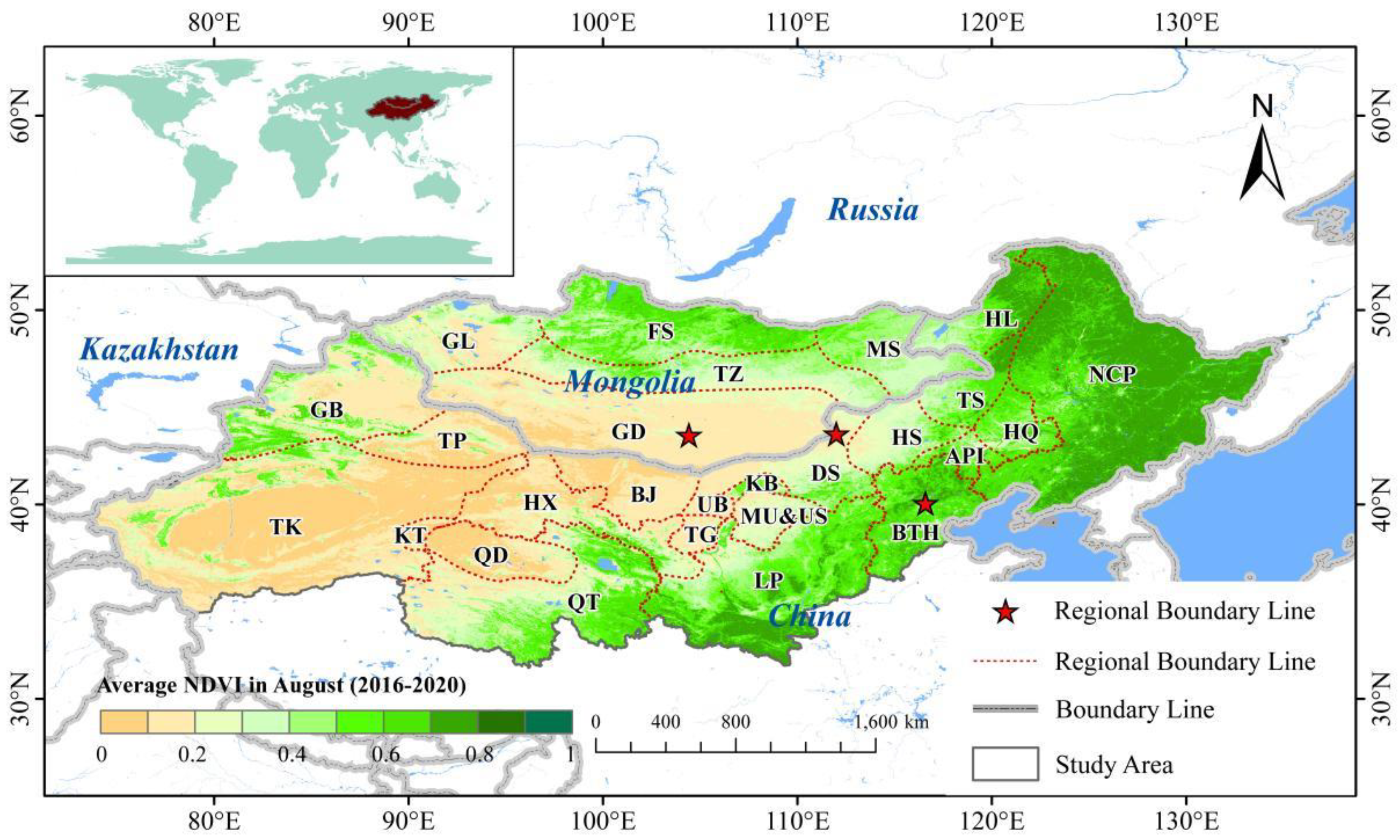
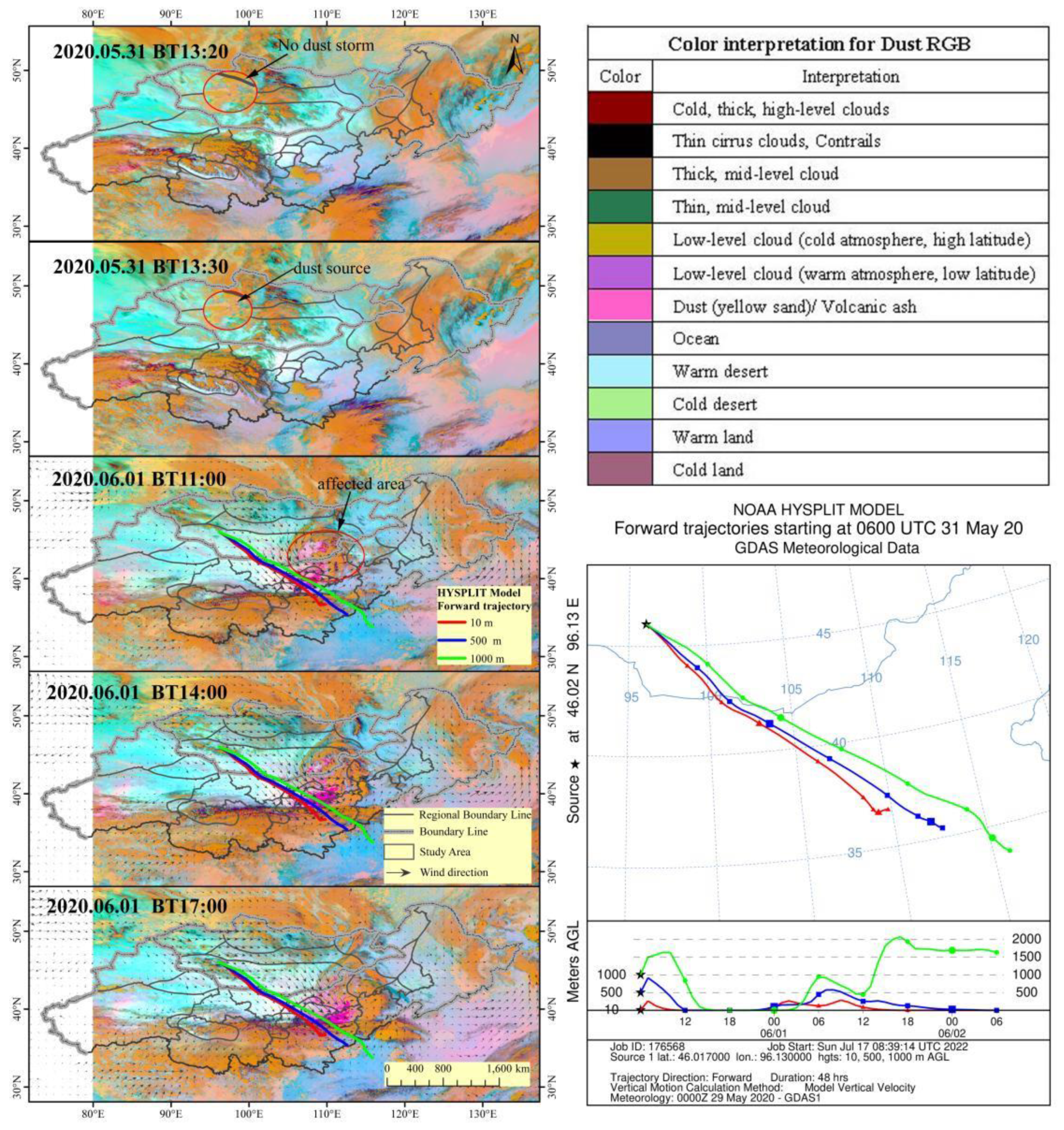

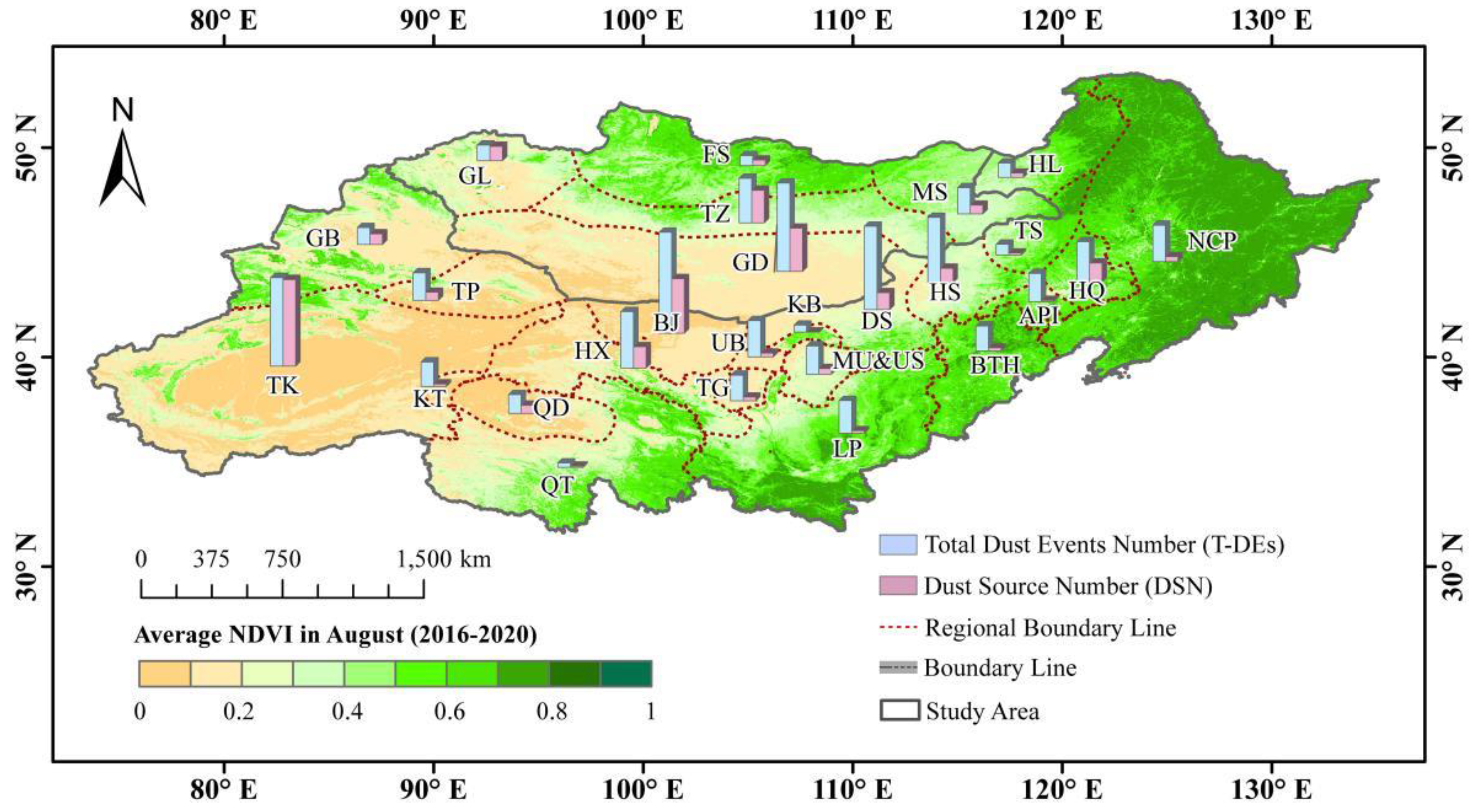
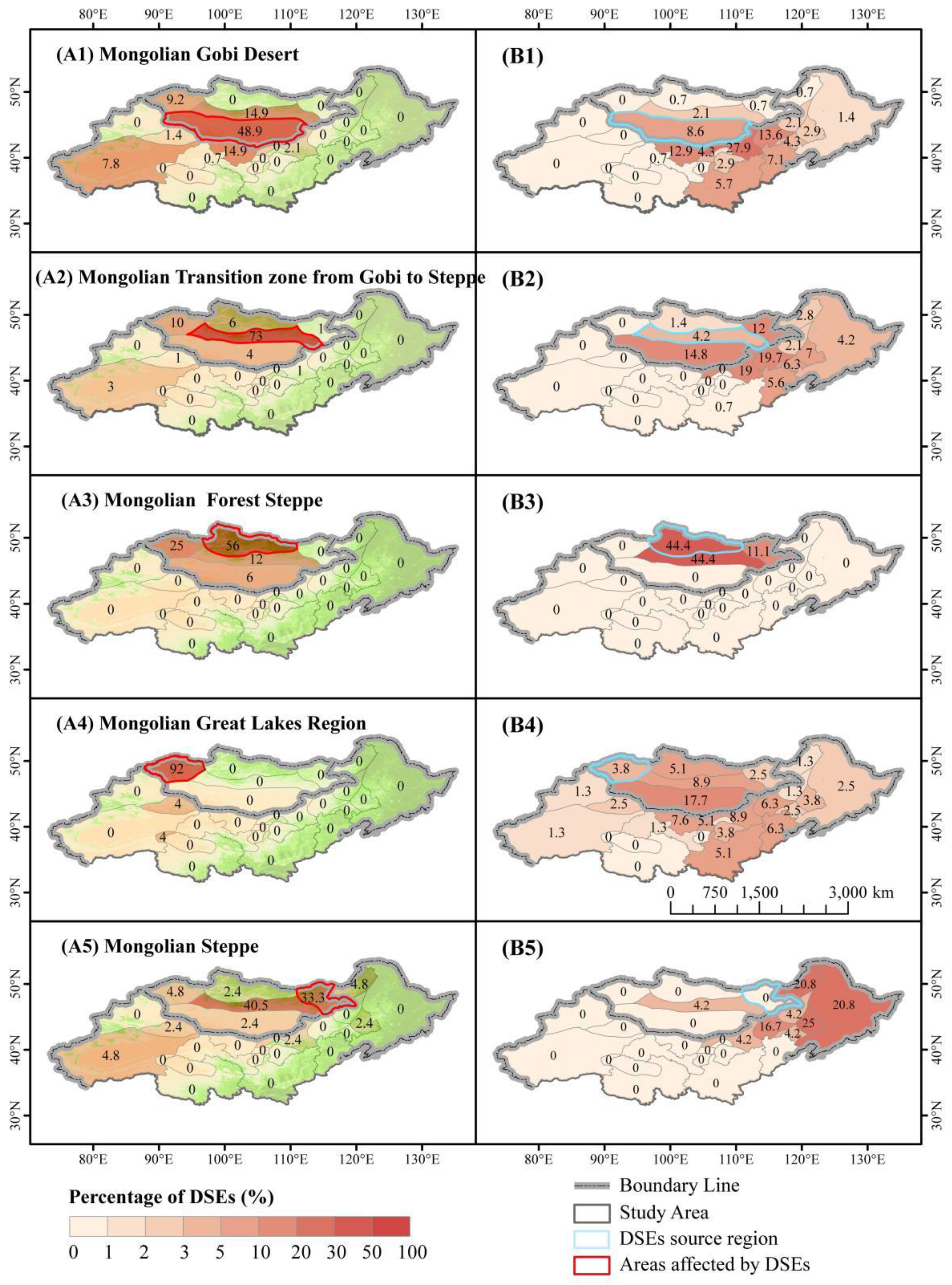
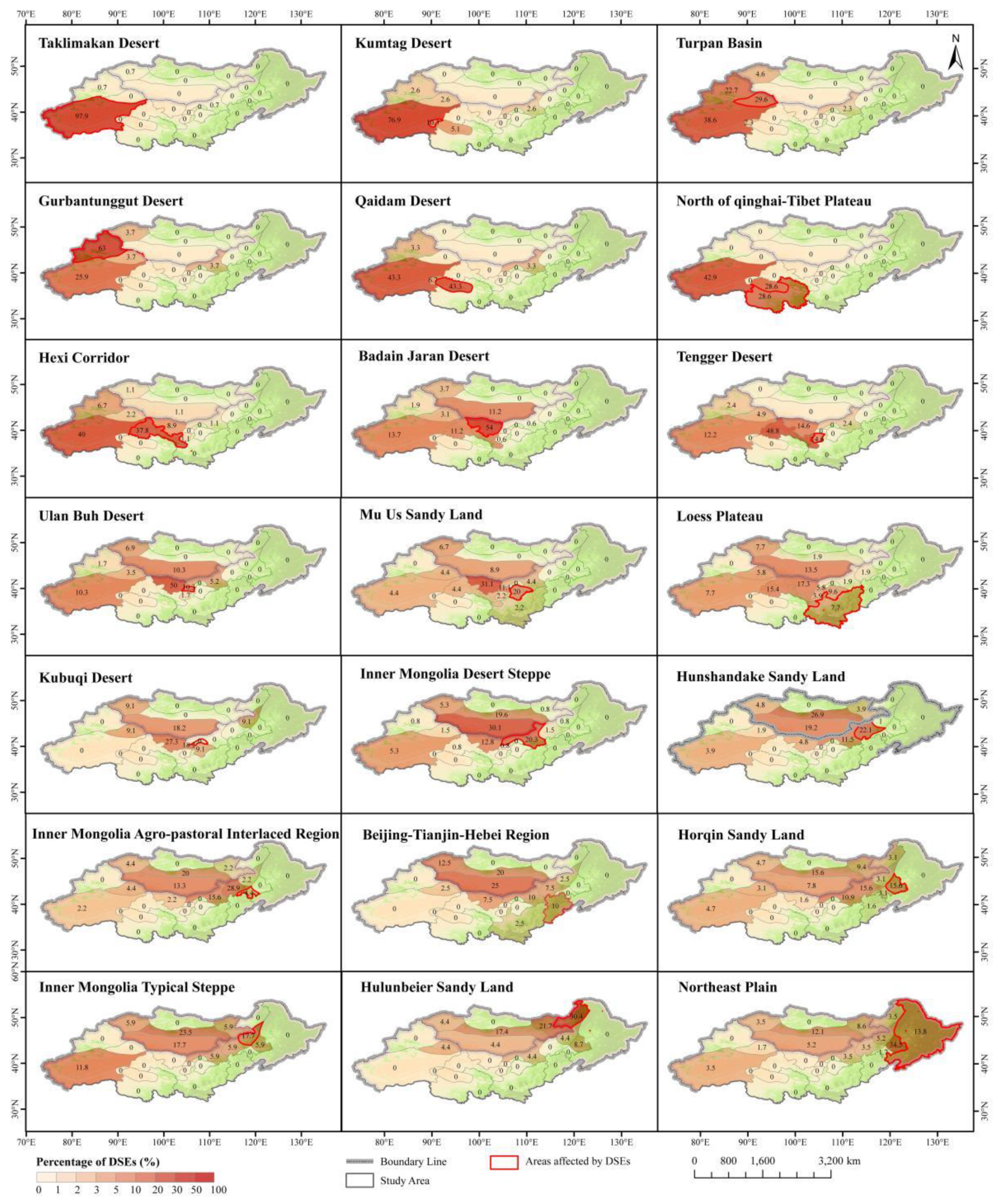


| Band | 1 | 2 | 3 | 4 | 5 | 6 | 7 | 8 | 9 | 10 | 11 | 12 | 13 | 14 | 15 | 16 |
|---|---|---|---|---|---|---|---|---|---|---|---|---|---|---|---|---|
| Wave length (μm) | 0.46 | 0.51 | 0.64 | 0.86 | 1.6 | 2.3 | 3.9 | 6.2 | 7.0 | 7.3 | 8.6 | 9.6 | 10.4 | 11.2 | 12.3 | 13.3 |
| Area | FS | MS | GD | GL | TZ | BJ | QD | NCP | GB | HX | HL | LP | HS |
| DSN | 9 | 14 | 69 | 23 | 52 | 87 | 13 | 8 | 17 | 34 | 7 | 4 | 23 |
| T-DEN | 16 | 42 | 141 | 25 | 71 | 161 | 30 | 58 | 27 | 90 | 23 | 52 | 104 |
| Area | BTH | HQ | KT | MU&US | TS | API | DS | QT | TK | TG | TP | UB | KB |
| DSN | 5 | 30 | 4 | 9 | 3 | 2 | 27 | 2 | 138 | 6 | 13 | 6 | 0 |
| T-DEN | 40 | 64 | 39 | 45 | 17 | 45 | 133 | 7 | 141 | 41 | 44 | 58 | 11 |
Publisher’s Note: MDPI stays neutral with regard to jurisdictional claims in published maps and institutional affiliations. |
© 2022 by the authors. Licensee MDPI, Basel, Switzerland. This article is an open access article distributed under the terms and conditions of the Creative Commons Attribution (CC BY) license (https://creativecommons.org/licenses/by/4.0/).
Share and Cite
Bao, C.; Yong, M.; Bueh, C.; Bao, Y.; Jin, E.; Bao, Y.; Purevjav, G. Analyses of the Dust Storm Sources, Affected Areas, and Moving Paths in Mongolia and China in Early Spring. Remote Sens. 2022, 14, 3661. https://doi.org/10.3390/rs14153661
Bao C, Yong M, Bueh C, Bao Y, Jin E, Bao Y, Purevjav G. Analyses of the Dust Storm Sources, Affected Areas, and Moving Paths in Mongolia and China in Early Spring. Remote Sensing. 2022; 14(15):3661. https://doi.org/10.3390/rs14153661
Chicago/Turabian StyleBao, Chunling, Mei Yong, Cholaw Bueh, Yulong Bao, Eerdemutu Jin, Yuhai Bao, and Gomboluudev Purevjav. 2022. "Analyses of the Dust Storm Sources, Affected Areas, and Moving Paths in Mongolia and China in Early Spring" Remote Sensing 14, no. 15: 3661. https://doi.org/10.3390/rs14153661
APA StyleBao, C., Yong, M., Bueh, C., Bao, Y., Jin, E., Bao, Y., & Purevjav, G. (2022). Analyses of the Dust Storm Sources, Affected Areas, and Moving Paths in Mongolia and China in Early Spring. Remote Sensing, 14(15), 3661. https://doi.org/10.3390/rs14153661








